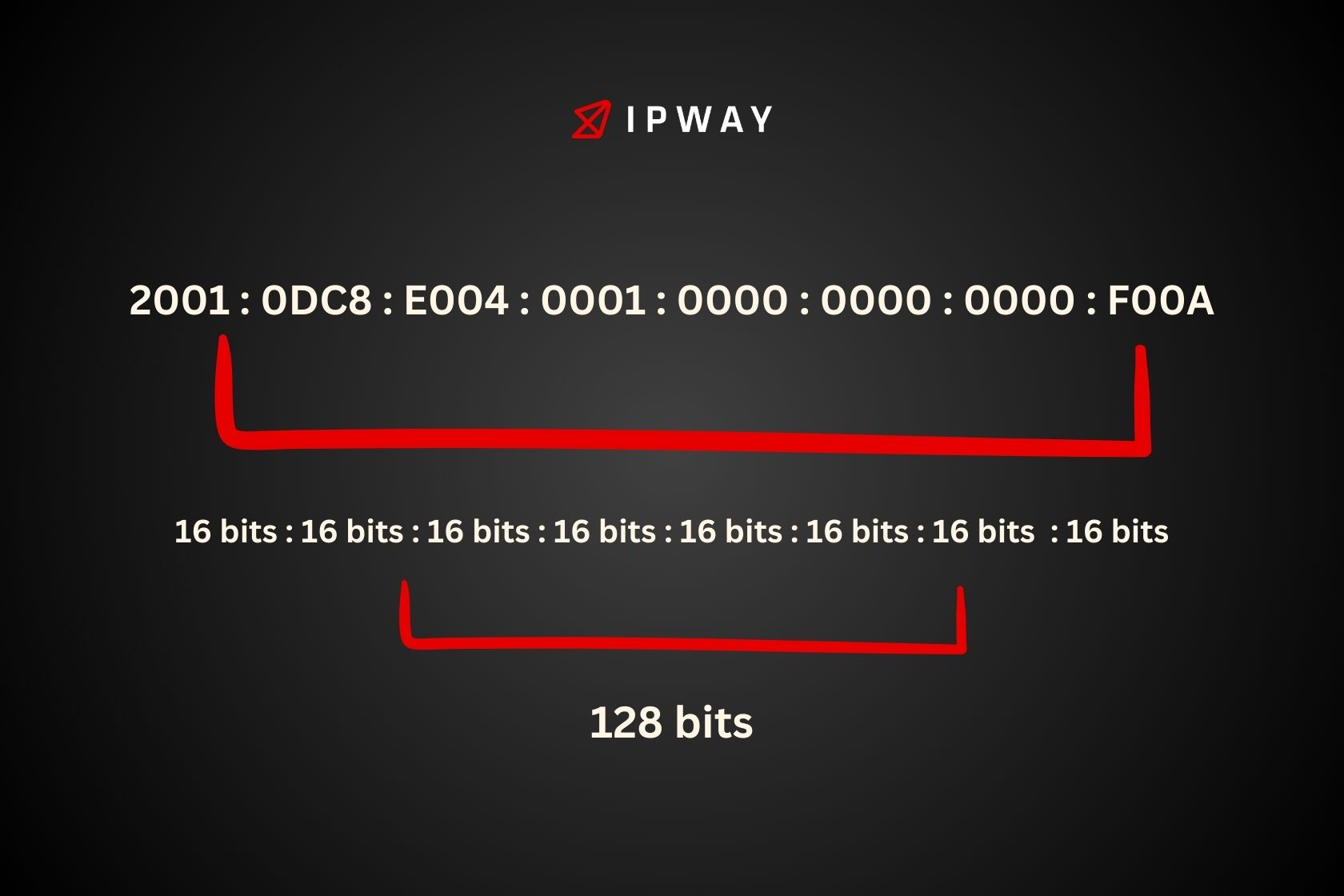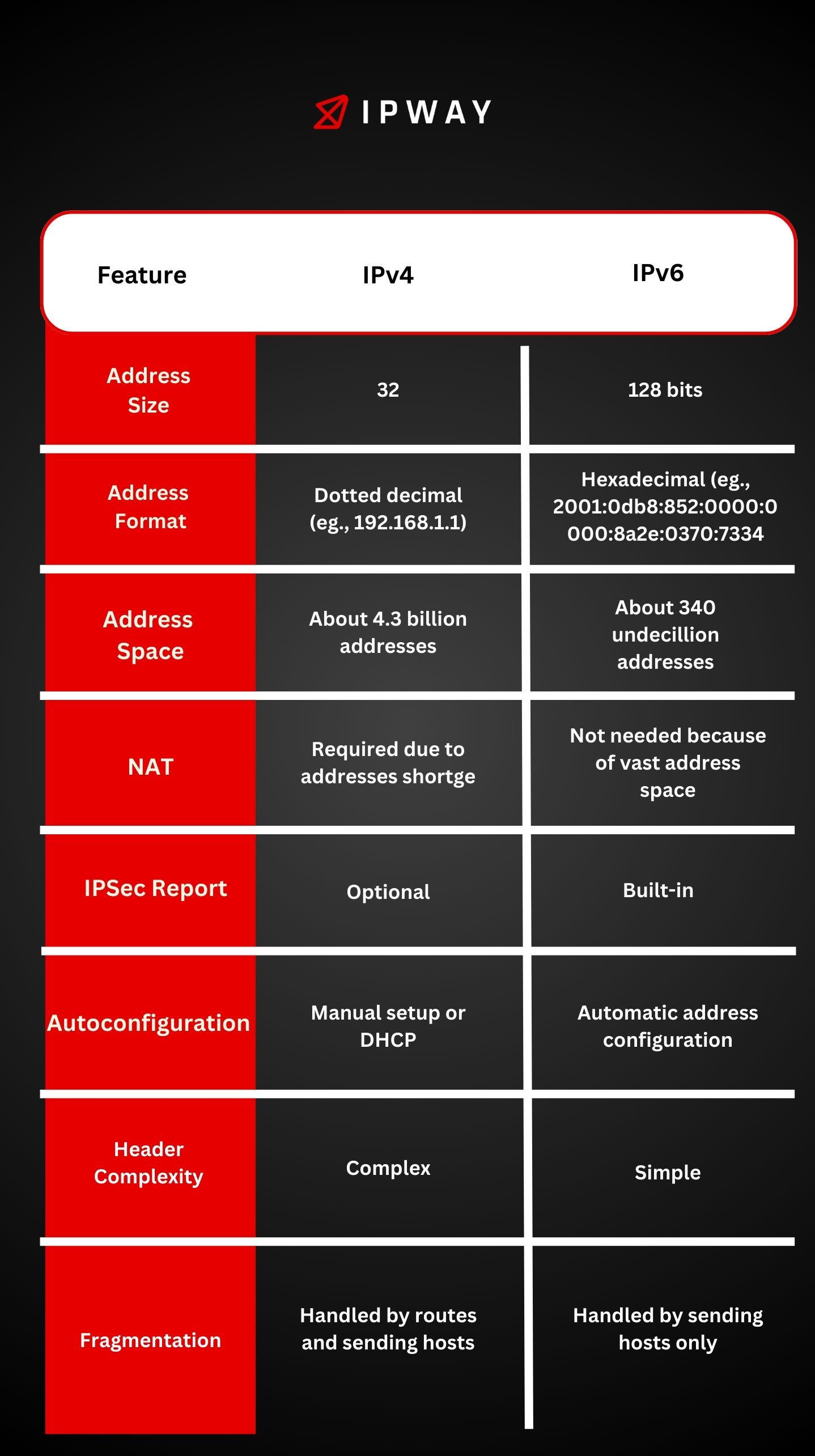What is IPv6? In the growing digital realm there is a rising need for increased IP addresses. The conventional IPv4 protocol, which offers 4.3 billion addresses is no longer adequate. Introducing IPv6, the innovative Internet Protocol developed to overcome this constraint. This piece will explore the essence of IPv6, its format, variations, benefits, drawbacks and the shift, from IPv4.
What is IPv6?
IPv6, also known as Internet Protocol version 6 is the recent iteration of the Internet Protocol (IP) created to supplant IPv4 because of its restricted address capacity. Developed by the Internet Engineering Task Force (IETF) in December 1998 IPv6 aims to meet the increasing demand, for IP addresses to support the expanding array of internet connected devices.
IPv4, the version employs 32 bit addresses resulting in a finite number of around 4.3 billion distinct addresses. Initially deemed satisfactory this figure has proven insufficient with the surge in internet usage proliferation of devices and the rise of the Internet of Things (IoT). The exhaustion of IPv4 addresses has spurred the demand, for a protocol prompting the creation and deployment of IPv6.
IPv6 employs 128 bit addresses significantly boosting the quantity of unique IP addresses to around 340 undecillion (340 trillion trillion trillion). This extensive address range guarantees that the depletion of IP addresses is unlikely, in the future facilitating the ongoing growth of the internet and the widespread use of interconnected devices.
The adoption of IPv6 has been gradual, largely due to the extensive infrastructure already in place for IPv4 and the need for compatibility during the transition period. However, the advantages of IPv6 make it a crucial development for the future of internet connectivity, ensuring scalability, security, and efficiency for the growing digital world.

Structure of IPv6 Addresses
An IPv6 address consists of 128 bits, represented as eight groups of four hexadecimal digits separated by colons (e.g., 2001:0db8:85a3:0000:0000:8a2e:0370:7334). To simplify reading and writing these addresses, you can apply the following techniques:
- Skip Leading Zeros: Omit leading zeros in any group.
- Example: 2001:db8:85a3:0:0:8a2e:370:733
- Use Double Colons (::): Replace a single continuous sequence of zeros with double colons, but only once in an address to avoid ambiguity.
- Example: 2001:db8:85a3::8a2e:370:7334

Types of IPv6 Addresses
In network communication IPv6 addresses are classified into three types; unicast, multicast and anycast each, with specific roles to play.
Unicast Addresses
Unicast addresses are utilized to pinpoint an interface on a device. Data packets dispatched to an address are directed to the particular interface linked to that address. There are several types of unicast addresses:
- Global Unicast Addresses: These addresses share a resemblance to IPv4 addresses and can be navigated on the internet. The Internet Assigned Numbers Authority (IANA) assigns them following a structure that includes a global routing prefix, subnet identifier and interface identifier.
- Link-Local Addresses: Link local addresses play a role in network operations where routable addresses are not needed. They enable communication among devices within the network segment and are automatically set up playing a key role, in supporting the Neighbor Discovery Protocol and other local network operations.
- Unique Local Addresses (ULAs): ULAs are created for communication within local networks and cannot be used on the worldwide internet. They offer a method to guarantee addresses within a private network and, across various interconnected sites that do not need global internet access.
Multicast Addresses
Multicast addresses are utilized for transmitting data to interfaces usually associated with different devices. Information transmitted to an address is distributed to all interfaces that belong to the multicast group identified by that address. In IPv6 multicast addresses consistently commence with the prefix.
- Solicited-Node Multicast Addresses: In the Neighbor Discovery Protocol these are employed to efficiently resolve addresses and detect addresses. Every IPv6 device receives a solicited node multicast address to lessen the volume of communications, on the network.
- Multicast Scope: IPv6 multicast addresses come with a scope field that specifies the extent to which the multicast is spread like link local, site local or global. This aids, in managing the distribution of multicast traffic.
Anycast Addresses
Anycast addresses are allocated to interfaces typically across different devices. Information transmitted to an anycast address is routed to the interface based on the routing protocol in place. Anycast addresses play a role, in improving service reliability and distributing loads efficiently.
- Service-Based Anycast: Anycast addresses are commonly utilized for services that aim to route traffic to the most efficient server like DNS root servers or content delivery networks (CDNs) thus improving the speed and dependability of the service.
- Network-Based Anycast: Anycast addresses, in networking help enhance load balancing and redundancy. For instance numerous routers can utilize the anycast address to evenly distribute incoming traffic and ensure fault tolerance.
Understanding the forms of IPv6 addresses enables network administrators to create and deploy network infrastructures that are both efficient and scalable making full use of the benefits offered by IPv6.
IPv6 Subnetting
Subdividing an IPv6 network into smaller segments, known as subnets is a fundamental practice in network management. This method plays a role, in structuring network architecture improving routing effectiveness and bolstering security measures.
Subnetting Basics
In IPv6 subnetting is the process of dividing a network into sub networks. This is achieved by modifying the subnet prefix, which forms part of the address and specifies the network segment. The length of the subnet prefix is denoted in CIDR (Classless Inter Domain Routing) notation like /64, /48 or /32.
- Global Routing Prefix: The ISP assigns this prefix, to a website showing the networks routing prefix.
- Subnet ID: The ISP assigns this prefix, to a website showing the networks routing prefix.
- Interface ID: Each interface, in a subnet has its distinct identifier.
For example, in the address 2001:db8:1234:5678::/64:
- The first 64 bits (2001:db8:1234:5678) represent the network prefix.
- The remaining 64 bits are used for the interface ID.
Subnetting Techniques
Choosing the Prefix Length: The length of the prefix decides how big the subnet is. Standard prefix lengths include /48, /56 and /64. A /64 prefix is usually chosen for subnets allowing for 2^64 potential addresses, in each subnet.
Hierarchical Subnetting: One way to approach this is by organizing subnetworks in a manner to make management easier and enhance routing effectiveness. To illustrate you can break down a /48 prefix, into /64 subnets.
Variable Length Subnet Masking (VLSM): Variable Length Subnet Masking (VLSM) enables a network to subnet flexibly by adjusting the length of the subnet prefix. This method is useful, for allocating addresses by tailoring subnet sizes to meet particular requirements.
Practical Considerations
Address Planning: Efficient planning of IPv6 subnets is crucial to make the use of address space and streamline network administration.
Scalability: IPv6 subnetting allows for the generation of a number of subnets, which can adapt to the expanding needs of networks, in the future.
Security: Segmenting a network into isolated sub networks through subnetting can boost network security by minimizing the vulnerability to large scale attacks.
Example of Subnetting
In an IPv6 network using a /48 routing prefix (2001;db8;abcd;;/48) it’s possible to split the network into various /64 subnets.
- 2001:db8:abcd:0001::/64
- 2001:db8:abcd:0002::/64
- 2001:db8:abcd:0003::/64
Each /64 subnet can support a vast number of unique addresses, making IPv6 highly scalable.
Advantages of IPv6
Increased Address Space: IPv6 provides a larger pool of IP addresses compared to IPv4 guaranteeing that we won’t face any shortage of addresses in the near future.
Simplified Header Format: The format of IPv6 headers is simplified to enhance the efficiency of processing packets.
Enhanced Security: IPv6 comes with IPsec as an element offering built in encryption and authentication.
Better Multicast and Anycast Capabilities: Enhanced backing, for multicast and anycast addresses boosts the effectiveness of transmitting data to destinations.
Auto-configuration: Devices connected to an IPv6 network can automatically configure themselves using stateless address autoconfiguration (SLAAC).
Disadvantages of IPv6
While IPv6 offers numerous advantages, it also presents several challenges and drawbacks that have impacted its widespread adoption:
Slow Adoption Rate: The shift from IPv4, to IPv6 has been gradual. This is mainly because of the expenses and challenges linked to enhancing current network systems. Companies need to spend on equipment, programs and education which can pose a notable financial strain.
Compatibility Issues: IPv6 and IPv4 do not work seamlessly together which creates issues with compatibility. Networks have to accommodate both protocols during the transition phase. This method of using both stacks at once demands resources making network management more complex and raising operational expenses. Special methods such as tunneling and translation become essential for bridging the gap, between IPv4 and IPv6 systems introducing layers of complexity and potential performance issues.
Increased Complexity: Implementing IPv6 may bring about challenges in network planning and administration. Network administrators must become well versed in IPv6 addressing, setup and issue resolution. This initial learning phase could potentially hinder the integration process. Raise concerns, about configuration errors and security threats.
Limited Support and Adoption: Even though IPv6 has been around for than twenty years its usage is still not widespread in various regions and sectors. A lot of systems, software and gadgets are built to work with IPv4, which leads to a reliance on the outdated protocol. This lack of uniformity could impede the transition, to IPv6 throughout the entire internet framework.
Security Concerns: IPv6 comes with security features such as IPsec. Setting it up isn’t always easy. Making mistakes. Not fully grasping it can leave the system vulnerable to security risks. Moreover the period, during which both IPv4 and IPv6 are active can introduce security weak points making network protection more challenging.
Address Management: While IPv6 offers a pool of addresses handling this space can pose difficulties. Effective planning and distribution of addresses are essential to prevent inefficiency and maintain top notch network efficiency. Companies need to embrace address management strategies, which may demand time and expertise in the field.
Transitioning to IPv6
Moving from IPv4 to IPv6 involves an step by step approach that demands thorough preparation and implementation. Various methods and tools are available to aid in this shift guaranteeing communication, between the two protocols.
Dual Stack
One popular technique is known as the stack method. This strategy entails setting up network devices to operate IPv4. Ipv6 protocols at the same time. By accommodating both protocols devices can interact using either IPv4 or IPv6 guaranteeing compatibility, with IPv4 infrastructure while gradually transitioning to IPv6. Nevertheless this method demands memory and computational resources since devices must sustain two distinct protocol stacks.
Tunneling
During the transition phase tunneling is a method often employed. It entails wrapping IPv6 packets in IPv4 packets to navigate through IPv4 networks. This approach enables IPv6 data to move across IPv4 infrastructure. Some typical tunneling methods are;
- 6to4 Tunneling: This system lets IPv6 packets travel through an IPv4 network by inserting IPv6 addresses into IPv4 headers. It allows for tunneling without requiring predefined tunnel endpoints.
- Teredo Tunneling: Teredo enables devices behind IPv4 NAT (Network Address Translation) to connect via IPv6 by wrapping IPv6 packets in UDP (User Datagram Protocol) IPv4 packets. This approach helps resolve challenges, with NAT traversal.
- ISATAP (Intra-Site Automatic Tunnel Addressing Protocol): ISATAP enables the transmission of IPv6 packets over an IPv4 network, within a location by utilizing the IPv4 network as a virtual link layer.
Translation
Translation methods are utilized to facilitate interaction, between IPv6 and IPv4 devices. This method entails converting headers and payloads between the two protocols. The two main translation mechanisms are:
- NAT64: NAT or Network Address Translation is a technique that converts IPv6 addresses to IPv4 addresses and vice versa. With NAT64 IPv6 only devices can interact with only devices by linking IPv6 addresses to IPv4 addresses and carrying out the required translation.
- DNS64: DNS64 collaborates with NAT64 to allow IPv6 only users to convert IPv4 addresses. It generates IPv6 addresses from IPv4 addresses during DNS requests easing communication, between IPv6 and IPv4 networks.
Planning and Implementation
Successful transition to IPv6 requires careful planning and implementation. Organizations need to:
- Assess Readiness: Evaluate the existing network setup, devices, software and services meticulously to ascertain if they are compatible, with IPv6.
- Develop a Transition Plan: Develop a transition strategy that lays out the process, schedules and resources required for the migration. This strategy should encompass approaches, for dual stack implementation, tunneling and translation when necessary.
- Upgrade Infrastructure: To enhance the network infrastructure consider upgrading the hardware, software and firmware to accommodate IPv6. This could entail the replacement or reconfiguration of routers, switches, firewalls and other networking devices.
- Training and Education: Make sure to train and educate IT personnel and network administrators so they have a grasp of IPv6 principles, setup and problem solving.
- Test and Validate: Incorporate IPv6 into a controlled testing setting to pinpoint and address any issues prior to rolling it out fully. This measure is essential to guarantee a transition without causing disruptions, to network functions.
- Gradual Deployment: Roll out IPv6 incrementally, starting with non-critical systems and gradually expanding to core network infrastructure. This phased approach minimizes risk and allows for adjustments based on real-world experiences.
Conclusion
Moving from IPv4 to IPv6 is crucial for the internets expansion and effectiveness. IPv6 provides a pool of addresses, better security functions and improved performance abilities to overcome the drawbacks of IPv4. Nevertheless this shift comes with obstacles such, as compatibility concerns, added intricacy and substantial expenses.
Despite facing these challenges the long term advantages of adopting IPv6 are significant. By grasping the structure of IPv6, address types, subnetting techniques and transition plans companies can seamlessly strategize and execute their shift, to this modern protocol. Embracing IPv6 guarantees a secure and effective network setup that can accommodate future technological progressions and the increasing array of internet connected gadgets.
Become a part of the IPWAY network and benefit from automated IP leasing with unparalleled convenience.
